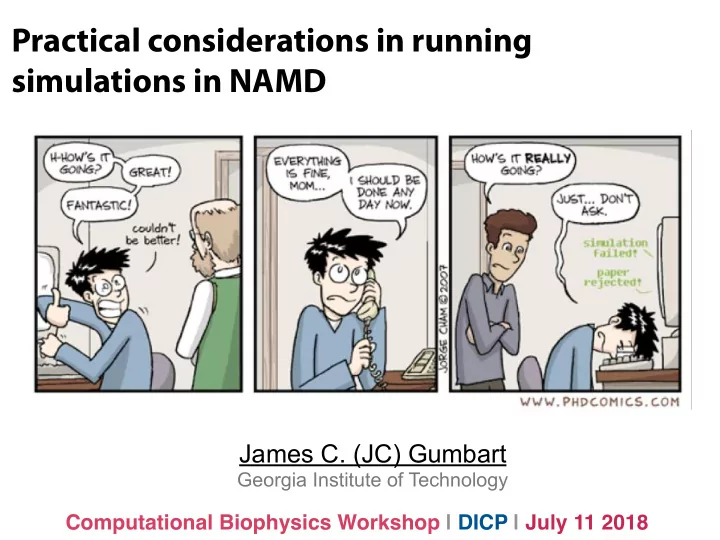

Practical considerations in running simulations in NAMD James C. (JC) Gumbart Georgia Institute of Technology Computational Biophysics Workshop | DICP | July 11 2018
PDB fi les provide structure and starting positions of atoms Simulations start with a crystal structure from the Protein Data Bank, in the standard PDB file format. • PDB files contain standard records for species, tissue, authorship, citations, sequence, secondary structure, etc. • We only care about the atom records… http://www.rcsb.org/ – atom name (N, C, CA) – residue name (ALA, HIS) – residue id (integer) – coordinates (x, y, z) – occupancy (0.0 to 1.0) – temp. factor (a.k.a. beta) – segment id (6PTI) • No hydrogen atoms! (usually) We must add them ourselves.
Structure of a PDB File It is an ASCII, fixed-width file, which generally does not contain any connectivity information
PSF fi les provide the topology and charges Every atom in the simulation is listed. • Provides all static atom-specific values: – atom name (N, C, CA) – atom type (NH1, C, CT1) – residue name (ALA, TRP) – residue id (integer) – segment id (6PTI) – atomic mass (in atomic mass units) – partial charge (in electronic charge units) • What is not in the PSF file? – coordinates (dynamic data, initially read from PDB file) – velocities (dynamic data, initially from Boltzmann distribution) – force field parameters (non-specific, used for many molecules)
Structure of a PSF fi le Also an ASCII, fixed-width file, which does not contain coordinate information
Structure of a PSF fi le (extended) “Extended” format supports long atom types and names ( > 4 characters) Current versions of NAMD and VMD handle this automatically “ EXT ” at the beginning of the file indicates extended format
Structure of a topology fi le Topology files contain instructions for building different types of biomolecules, used to build the PSF residue name, total charge atom name, type, charge (after ! is a comment) groups not required, but generally indicate sets of atoms with integer charges bonds explicitly listed, but not angles, dihedrals impropers maintain planarity adjustment to dihedral terms from QM for proteins ignored Internal coords. help build missing atoms
Structure of a parameter fi le Parameter files (used during simulation) tell NAMD what the force constants, etc. are - organized by atom type , not name entries for bonds, angles, dihedrals, impropers, and LJ ! comments type 1 type 2 force constant eq. bond length NOTE : always check for the latest force-field files ( multiple topology and parameters) at their source - we currently use CHARMM36 http://mackerell.umaryland.edu/charmm_ff.shtml
Measuring performance Check your scaling!!! grep "Benchmark" *log Info: Benchmark time: 42 CPUs 0.0879267 s/step 1.01767 days/ns 87.665 MB memory TYPICAL RANGE: 250-1000 atoms/core grep “TIMING" *log TIMING: 3000 CPU: 346.34, 0.07938/step Wall: 466.648, 0.0879514/step, 6.08331 hours remaining , 88.341812 MB of memory in use.
Dealing with crashes Some errors are obvious… “Cannot specify both an initial temperature and a velocity file” "stepsPerCycle must be a multiple of fullElectFrequency" etc…
Others not so much… FATAL ERROR: Periodic cell has become too small for original patch grid! Possible solutions are to restart from a recent checkpoint, increase margin, or disable useFlexibleCell for liquid simulation. -relates to how NAMD parallelizes the simulation Atoms that move close enough to interact (defined by cutoff) but are not on neighboring patches causes a crash -typically happens because of large volume fluctuations (normal during initial equilibriation in NpT ensemble), but CHECK OUTPUT TO BE SURE **can set “margin 2” (force bigger patches) in configuration file **lower “stepsPerCycle” in configuration file **just restart
Missing parameters? DIDN'T FIND vdW PARAMETER FOR ATOM TYPE CT3 **Did you specify all the needed parameter files? **Was your system (PSF/PDB) constructed correctly? (Check for errors/warnings from PSFGen or AutoPSF!) **Do you have an unusual ligand? (need to either remove or develop parameters for it)
Simulation instability ERROR: Atoms moving too fast; simulation has become unstable. ERROR: Constraint failure in RATTLE algorithm for atom 1897! Both errors almost always derive from bad system configurations! **Check your system in VMD near the noted atoms **Use the “measure contacts” command to check for atoms that are very close (say, within 0.1 Å) **Look for atoms at (0,0,0) whose positions didn’t get initialized when building PSF/PDB **Check that the periodic box dimensions are big enough **Minimize for longer, or set margin higher If all else fails, change your DCDFreq to 1 and watch the simulation up to the point of the crash very carefully NOTE: NAMD uses 1-based numbers whereas VMD typically uses 0-based In VMD - use “serial ____” instead of “index”
Simulation instability (cont.) FATAL ERROR: Bad global exclusion count. typically results from bad starting configuration, similar to previous errors -besides previous solutions, consider the possibility of missing angle or dihedral entries from the PSF file -when a patch is applied by PSFGen, the command “regenerate angles dihedrals” may need to be issued before guessing coordinates and writing the PSF (when in doubt, add it!)
any questions?
Recommend
More recommend